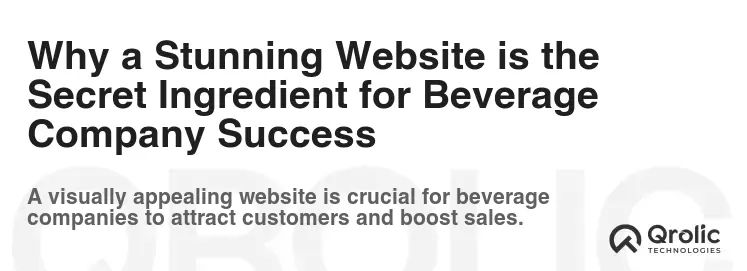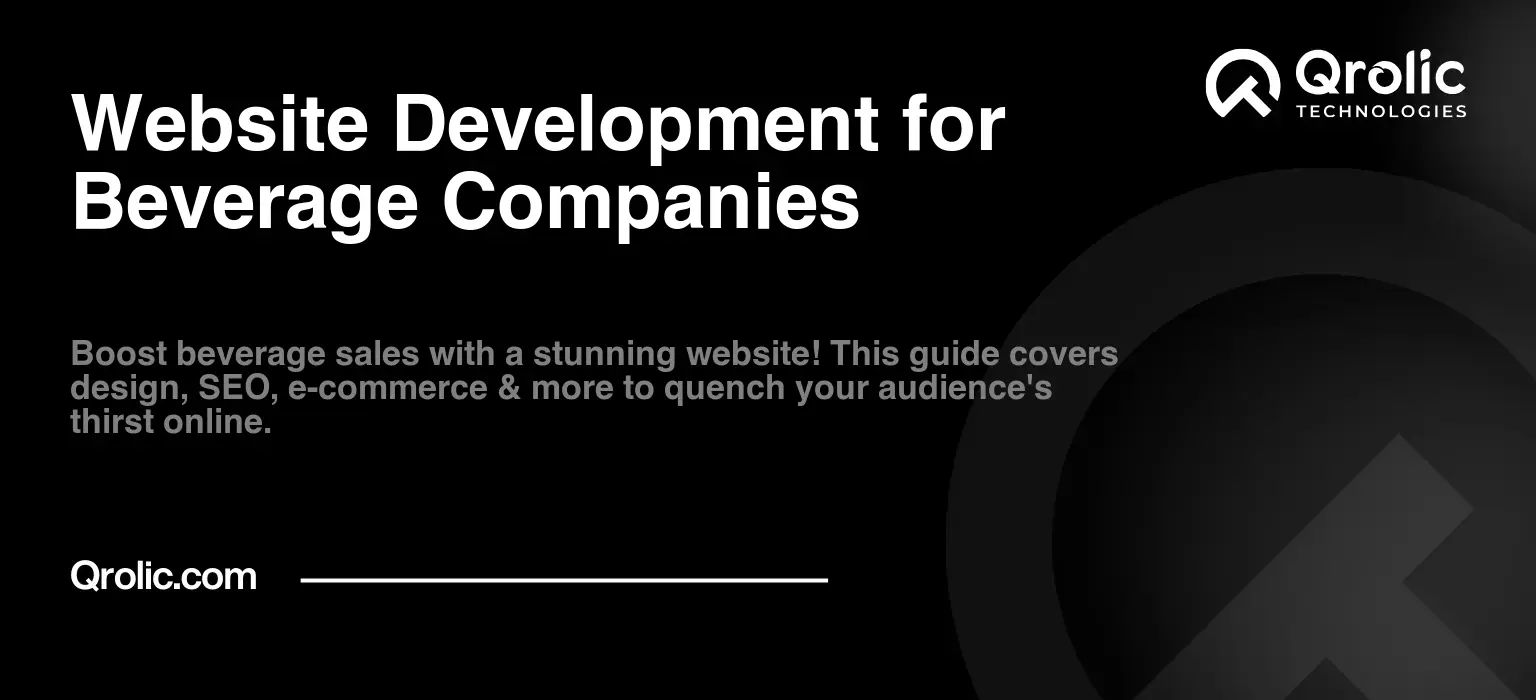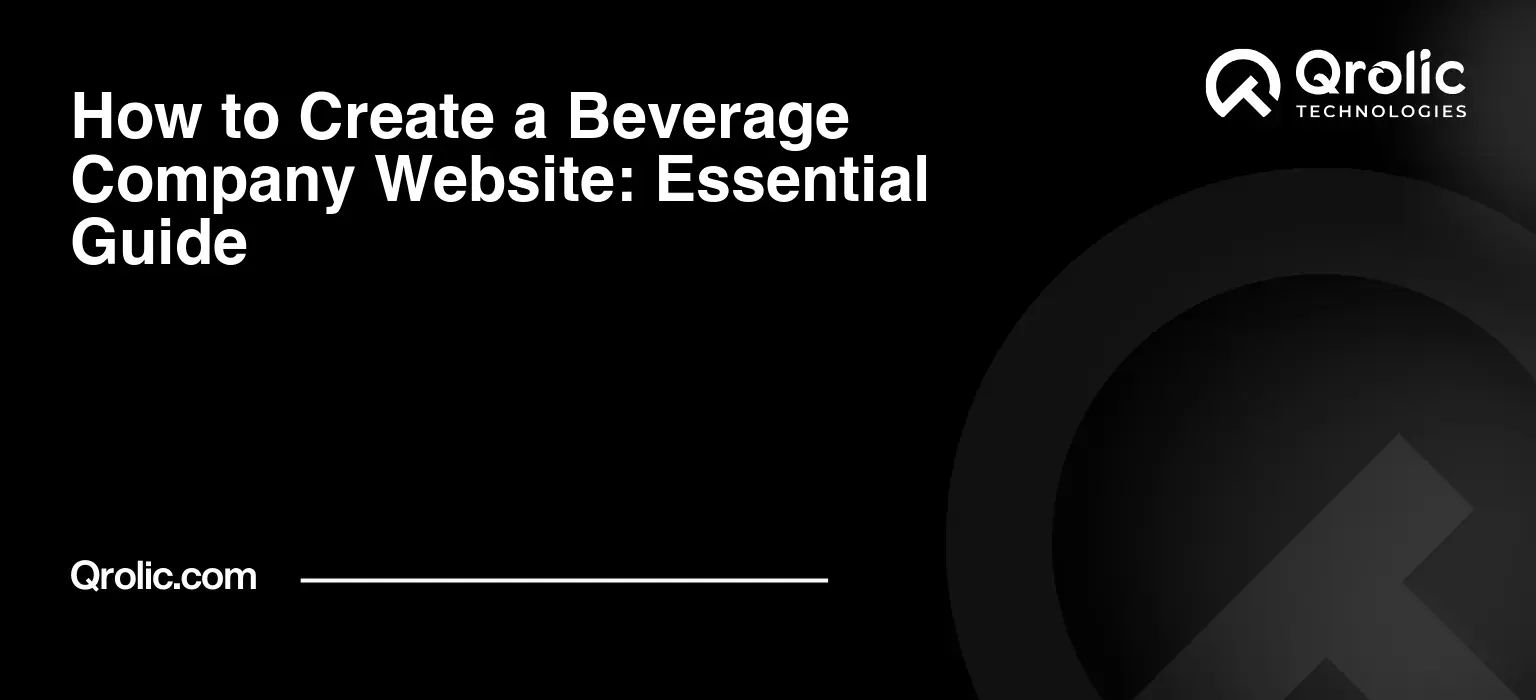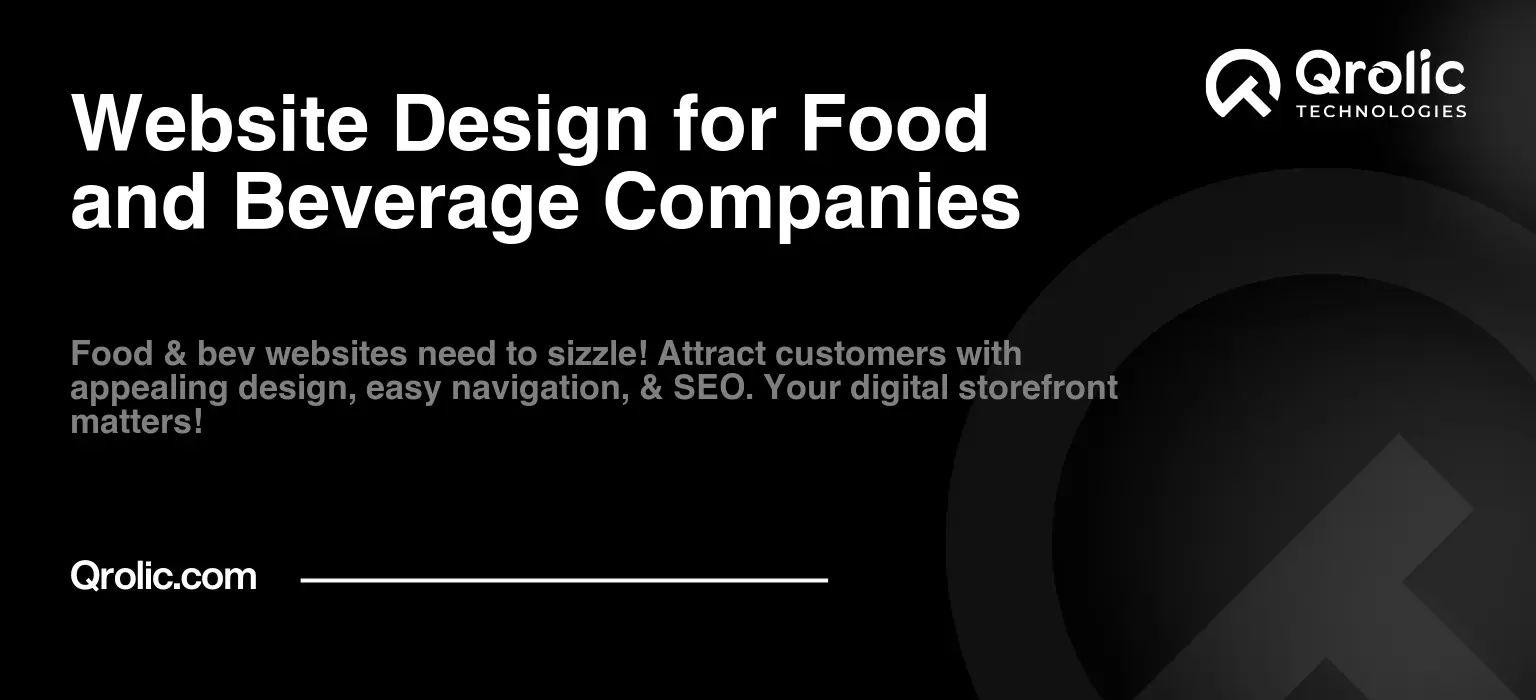Quick Summary:
- A stunning website is crucial for beverage brand success.
- Prioritize stunning visuals, mobile experience, and easy navigation.
- Optimize with SEO, engage through content, and sell online.
Table of Contents
- Why a Stunning Website is the Secret Ingredient for Beverage Company Success
- The Cost of a Bad Website: More Than Just Lost Sales
- Understanding Your Target Audience: Who Are You Serving?
- Food Industry Web Design: Key Considerations for the Beverage Sector
- Essential Website Features for Beverage Companies
- SEO Strategies to Thirst Trap Search Engines: Getting Found Online
- Keyword Integration Best Practices:
- Beverage Company Website Development Process: From Concept to Launch
- The Importance of High-Quality Visuals: A Picture is Worth a Thousand Sales
- The Power of Storytelling: Connecting with Your Audience on an Emotional Level
- Integrating E-Commerce Functionality: Selling Beverages Online
- Measuring Website Success: Tracking Key Metrics
- Beverage Website Design Trends: Staying Current
- Choosing the Right Web Development Partner: Finding a Perfect Blend
- Qrolic Technologies: Crafting Digital Experiences That Quench Your Audience’s Thirst
- Future-Proofing Your Website: Adapting to the Changing Digital Landscape
Why a Stunning Website is the Secret Ingredient for Beverage Company Success

In today’s fiercely competitive beverage market, a captivating website isn’t just an option; it’s the digital storefront, the brand ambassador, and the 24/7 salesperson all rolled into one. Consumers are increasingly researching products online before making a purchase, and a poorly designed or outdated website can send them running straight to your competitors. Think of your website as the first sip of your brand – it needs to be refreshing, engaging, and leave them wanting more. This guide delves into the crucial aspects of website development for beverage companies, ensuring you craft a digital presence that truly quenches your audience’s thirst.
The Cost of a Bad Website: More Than Just Lost Sales
A clunky, slow, or uninformative website can have devastating consequences for your beverage business. These include:
- Lost Revenue: Potential customers bounce away, choosing competitors with a better online experience.
- Damaged Brand Reputation: A subpar website reflects poorly on the quality of your products and overall brand image.
- Reduced Customer Engagement: Lack of interactivity and compelling content can lead to decreased customer loyalty.
- Missed Marketing Opportunities: A weak website hinders your ability to run effective online marketing campaigns.
- Lower Search Engine Rankings: Google penalizes websites with poor user experience, pushing you further down the search results.
Understanding Your Target Audience: Who Are You Serving?
Before diving into design and development, it’s paramount to understand your target audience. Are you targeting health-conscious millennials with organic juices, busy parents seeking convenient and nutritious options, or cocktail enthusiasts looking for premium mixers? Each demographic has different needs, preferences, and online behaviors.
- Define Your Ideal Customer Persona: Create detailed profiles of your target customers, including their age, interests, online habits, and purchasing motivations.
- Conduct Market Research: Use surveys, focus groups, and social media listening to gather insights into your audience’s preferences and pain points.
- Analyze Competitor Websites: Identify what your competitors are doing well and where they are falling short in terms of user experience and content.
- Identify Key Purchase Drivers: What factors influence your target audience’s beverage purchasing decisions (e.g., taste, health benefits, price, convenience)?
Food Industry Web Design: Key Considerations for the Beverage Sector
The food industry web design is a unique niche, and beverage websites require specific attention to detail. Here are some essential elements:
- High-Quality Visuals: Mouthwatering photos and videos are crucial for showcasing your beverages in their most appealing light. Invest in professional food photography that captures the texture, color, and overall deliciousness of your products.
- Mobile Optimization: A significant portion of online traffic comes from mobile devices. Ensure your website is fully responsive and provides a seamless user experience on smartphones and tablets.
- Easy Navigation: Make it easy for visitors to find the information they need, whether it’s product details, nutritional information, or retail locations. Use clear and concise menus, search functionality, and breadcrumb navigation.
- Detailed Product Information: Provide comprehensive product descriptions, including ingredients, nutritional facts, flavor profiles, and potential allergens. Highlight any unique selling points or health benefits.
- Interactive Elements: Engage visitors with interactive elements like quizzes, polls, recipe suggestions, and virtual tasting experiences.
- Compliance with Regulations: Ensure your website complies with all relevant food labeling regulations and guidelines, providing accurate and up-to-date information.
- Security: Implement robust security measures to protect customer data and prevent cyberattacks. Use SSL certificates and regularly update your website’s software.
Essential Website Features for Beverage Companies
A successful beverage company website incorporates several key features that enhance user experience and drive sales.
- Product Catalog: A visually appealing and easily searchable catalog showcasing your entire beverage lineup.
- Detailed Product Pages: Dedicated pages for each product with high-quality images, descriptions, nutritional information, and customer reviews.
- Retail Locator: A tool that allows customers to find the nearest stores or restaurants that carry your products.
- Online Ordering (if applicable): Enable direct-to-consumer sales through an e-commerce platform integrated into your website.
- Recipe Section: Provide delicious and creative recipes that feature your beverages, inspiring customers to use them in new ways.
- Blog: Share engaging content related to your beverages, industry trends, health benefits, and company news.
- Contact Form: Make it easy for customers to reach out with questions, feedback, or inquiries.
- Social Media Integration: Seamlessly connect your website with your social media channels to expand your reach and engage with your audience.
- Subscription Option: Allow users to subscribe to your newsletter to receive updates about new products, promotions, and events.
- Customer Reviews and Testimonials: Showcase positive customer reviews and testimonials to build trust and credibility.
- FAQ Section: Address common questions about your products, ingredients, and company policies.
- Multi-Language Support: If you target international markets, offer your website in multiple languages.
- Accessibility Features: Ensure your website is accessible to users with disabilities, complying with WCAG guidelines.
SEO Strategies to Thirst Trap Search Engines: Getting Found Online
Beverage company website development isn’t just about aesthetics; it’s also about visibility. Search Engine Optimization (SEO) is crucial for driving organic traffic to your website and attracting potential customers.
- Keyword Research: Identify the keywords that your target audience uses when searching for beverages like yours. Use tools like Google Keyword Planner, Ahrefs, and SEMrush to find relevant and high-volume keywords. Include keywords like drink manufacturer website, beverage distributor website design, organic juice web design, and similar relevant terms.
- On-Page Optimization: Optimize your website’s content, title tags, meta descriptions, and image alt text with relevant keywords. Ensure your website is well-structured and easy for search engines to crawl.
- Off-Page Optimization: Build high-quality backlinks from reputable websites in the food and beverage industry. Engage in social media marketing to increase brand awareness and drive traffic to your website.
- Content Marketing: Create valuable and engaging content, such as blog posts, articles, and videos, that address your target audience’s needs and interests. Share your content on social media and other online channels.
- Local SEO: If you have a physical presence, optimize your website for local search. Create a Google My Business listing and ensure your business information is accurate and consistent across all online platforms.
- Technical SEO: Ensure your website is technically sound, with fast loading speeds, mobile-friendliness, and a secure connection. Fix any broken links or errors that could negatively impact your search engine rankings.
Keyword Integration Best Practices:
- Natural Language: Don’t stuff keywords artificially. Integrate them naturally into your content.
- Long-Tail Keywords: Target long-tail keywords (longer, more specific phrases) to capture niche audiences.
- Keyword Variations: Use variations of your primary keywords to avoid repetition and improve readability.
- Location-Based Keywords: If you serve a local market, include location-based keywords like “best juice bar in [city]”
Beverage Company Website Development Process: From Concept to Launch
Developing a successful website for a beverage company involves a structured process that includes planning, design, development, testing, and launch.
1. Planning and Strategy:
- Define Goals and Objectives: What do you want to achieve with your website? (e.g., increase brand awareness, generate leads, drive online sales)
- Identify Target Audience: Who are you trying to reach?
- Conduct Competitive Analysis: What are your competitors doing online?
- Develop a Content Strategy: What kind of content will you create?
- Choose a Domain Name: Select a domain name that is relevant to your brand and easy to remember.
- Select a Web Hosting Provider: Choose a reliable web hosting provider that can handle your website’s traffic and storage needs.
2. Design and Development:
- Create Wireframes and Mockups: Develop visual representations of your website’s layout and design.
- Choose a Website Platform: Select a content management system (CMS) like wordpress, Drupal, or Joomla, or opt for a custom-built website.
- Design the User Interface (UI): Create a visually appealing and user-friendly design that reflects your brand identity.
- Develop the Website Functionality: Implement the features and functionality outlined in your planning phase, such as a product catalog, online ordering, and a retail locator.
- Optimize for Mobile Devices: Ensure your website is responsive and provides a seamless user experience on all devices.
3. Testing and Quality Assurance:
- Test Functionality: Thoroughly test all website features to ensure they are working correctly.
- Check for Broken Links: Identify and fix any broken links or errors that could negatively impact user experience.
- Test Website Speed: Optimize your website’s loading speed to improve user experience and search engine rankings.
- Ensure Cross-Browser Compatibility: Test your website on different browsers (e.g., Chrome, Firefox, Safari) to ensure it displays correctly.
- Conduct User Testing: Gather feedback from real users to identify any areas for improvement.
4. Website Launch:
- Deploy Your Website: Transfer your website files to your web hosting server.
- Set Up Analytics Tracking: Install Google Analytics or other analytics tools to track website traffic and user behavior.
- Submit Your Website to Search Engines: Submit your website to Google and other search engines to ensure it gets indexed.
- Promote Your Website: Share your website on social media, email marketing campaigns, and other online channels.
5. Maintenance and Optimization:
- Regularly Update Your Website: Keep your website’s software and plugins up to date to ensure security and functionality.
- Monitor Website Performance: Track website traffic, user behavior, and search engine rankings to identify areas for improvement.
- Gather User Feedback: Continuously solicit feedback from users to identify and address any issues.
- Optimize for Search Engines: Continuously optimize your website for search engines to improve your rankings and drive more organic traffic.
- Refresh Content Regularly: Keep your content fresh and relevant by adding new blog posts, product updates, and other engaging content.
The Importance of High-Quality Visuals: A Picture is Worth a Thousand Sales
In the beverage industry, visuals are paramount. High-quality images and videos can significantly impact consumer perception and purchase decisions.
- Professional Photography: Invest in professional food photography that captures the texture, color, and overall deliciousness of your beverages.
- Lifestyle Imagery: Use lifestyle imagery to show your beverages being enjoyed in different settings and scenarios.
- Product Videos: Create engaging product videos that showcase your beverages’ unique features and benefits.
- Behind-the-Scenes Content: Share behind-the-scenes content that highlights your company’s values and production processes.
- Infographics: Use infographics to present complex information in a visually appealing and easy-to-understand format.
The Power of Storytelling: Connecting with Your Audience on an Emotional Level
Consumers are increasingly drawn to brands that have a compelling story to tell. Share your brand’s story on your website to connect with your audience on an emotional level.
- Company History: Share your company’s history and mission.
- Founder’s Story: Tell the story of how your company was founded and what inspired you to create your beverages.
- Values and Philosophy: Highlight your company’s values and philosophy.
- Sustainability Efforts: Share your company’s sustainability efforts and commitment to environmental responsibility.
- Community Involvement: Highlight your company’s involvement in the community.
- Customer Success Stories: Share stories of how your beverages have positively impacted your customers’ lives.
Integrating E-Commerce Functionality: Selling Beverages Online
If you plan to sell your beverages directly to consumers, you’ll need to integrate e-commerce functionality into your website.
- Choose an E-Commerce Platform: Select an e-commerce platform that meets your needs, such as Shopify, WooCommerce, or Magento.
- Set Up Product Listings: Create detailed product listings with high-quality images, descriptions, and pricing information.
- Implement a Secure Payment Gateway: Integrate a secure payment gateway to process online transactions safely and securely.
- Configure Shipping Options: Set up shipping options that are convenient and affordable for your customers.
- Manage Inventory: Implement an inventory management system to track your stock levels and prevent overselling.
- Provide Customer Support: Offer excellent customer support to address any questions or concerns that your customers may have.
Measuring Website Success: Tracking Key Metrics
To determine the effectiveness of your website, it’s essential to track key metrics such as:
- Website Traffic: Monitor the number of visitors to your website, the pages they visit, and the time they spend on each page.
- Bounce Rate: Track the percentage of visitors who leave your website after viewing only one page.
- Conversion Rate: Measure the percentage of visitors who complete a desired action, such as making a purchase or filling out a contact form.
- Search Engine Rankings: Monitor your website’s rankings in search engine results pages (SERPs) for relevant keywords.
- Social Media Engagement: Track the number of likes, shares, and comments on your social media posts.
- Customer Satisfaction: Gather feedback from customers to measure their satisfaction with your website and your products.
Beverage Website Design Trends: Staying Current
The world of web design is constantly evolving. Staying up-to-date with the latest trends can help you create a website that is both visually appealing and user-friendly. Some current trends include:
- Minimalism: Clean and simple designs that focus on showcasing your beverages.
- Bold Typography: Using large and eye-catching fonts to grab attention.
- Micro-Animations: Subtle animations that add visual interest and enhance user experience.
- Dark Mode: Offering a dark mode option for users who prefer a darker color scheme.
- Voice Search Optimization: optimizing your website for voice search queries.
- Augmented Reality (AR): Integrating AR experiences that allow users to virtually “try” your beverages.
Choosing the Right Web Development Partner: Finding a Perfect Blend
Selecting the right web development partner is crucial for creating a successful beverage company website. Look for a partner with:
- Experience in the Food and Beverage Industry: A proven track record of developing websites for beverage companies.
- A Strong Portfolio: Examples of their previous work that showcase their design and development skills.
- A Collaborative Approach: A willingness to work closely with you to understand your needs and goals.
- A Focus on User Experience: A commitment to creating websites that are user-friendly and engaging.
- SEO Expertise: Knowledge of search engine optimization best practices.
- Excellent Communication Skills: Clear and responsive communication throughout the development process.
Qrolic Technologies: Crafting Digital Experiences That Quench Your Audience’s Thirst
Qrolic Technologies (https://qrolic.com/) is a leading web development company specializing in creating captivating and effective websites for the food and beverage industry. We understand the unique challenges and opportunities that beverage companies face in the digital landscape, and we’re dedicated to helping you craft a digital presence that truly reflects your brand’s identity and drives results.
Our team of experienced designers, developers, and SEO experts work collaboratively to create custom websites that are visually stunning, user-friendly, and optimized for search engines. We offer a comprehensive range of services, including:
- Website Design and Development: We create custom websites that are tailored to your specific needs and goals.
- E-Commerce Integration: We integrate e-commerce functionality into your website, allowing you to sell your beverages directly to consumers.
- SEO and Digital Marketing: We help you improve your website’s search engine rankings and drive more organic traffic.
- Content Creation: We create engaging content that resonates with your target audience.
- Website Maintenance and Support: We provide ongoing website maintenance and support to ensure your website is always running smoothly.
At Qrolic Technologies, we’re passionate about helping beverage companies thrive in the digital world. We believe that a great website is the foundation for success, and we’re committed to creating websites that deliver results. Contact us today to learn more about how we can help you craft a digital experience that quenches your audience’s thirst.
Future-Proofing Your Website: Adapting to the Changing Digital Landscape
The digital landscape is constantly evolving, so it’s essential to future-proof your website to ensure it remains relevant and effective.
- Embrace New Technologies: Stay up-to-date with the latest web technologies and incorporate them into your website as appropriate.
- Focus on User Experience: Continuously improve your website’s user experience based on user feedback and analytics data.
- Adapt to Mobile Trends: Keep pace with the evolving mobile landscape and ensure your website is optimized for the latest mobile devices and operating systems.
- Prioritize Security: Implement robust security measures to protect your website from cyberattacks and data breaches.
- Invest in Ongoing Maintenance: Regularly maintain and update your website to ensure it remains secure, functional, and up-to-date.
By following these tips and strategies, you can create a beverage company website that is not only visually appealing but also drives results and helps you achieve your business goals. Remember, your website is often the first impression potential customers have of your brand, so make it count! A well-designed and optimized website is an investment that will pay off in the long run, helping you attract new customers, build brand loyalty, and grow your business.








